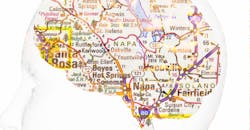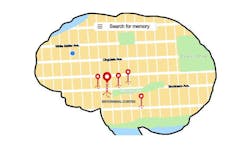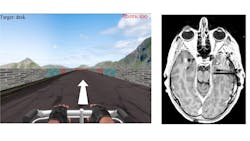Researchers Identify Neurons in the Brain that Map Memories
Biomedical researchers at Columbia University have correlated neurol activity in the entorhinal cortex, one of the first regions of the brain affected by the onset of Alzheimer’s disease, with place-based memories. This sheds new light on how the brain processes spatial memories.
Healthy people can recall specific moments from their vast array of experiences that occurred in a given setting. For example, if someone asks you to recommend a tourist itinerary for a city you have visited many times, your brain can selectively conjure up specific memories from your different trips to provide an answer.
Studies have shown that declarative memories—the kind you can consciously recall, such as your home address or your mother’s name—rely on healthy medial temporal lobe structures in the brain, including the hippocampus and entorhinal cortex (EC). These regions are also important for spatial cognition via “place” and “grid cells”, special neurons that activate to represent specific locations in the environment during navigation. However, it has never been clear if or how this “spatial map” in the brain relates to a person’s memory of events at those locations, and how neuron activity in these regions lets us target a particular memories for retrieval among similar experiences.
A team led by biomedical engineers at Columbia has found the first evidence that individual neurons in the human brain target specific memories during recall. They studied recordings from neurosurgical patients who already had electrodes implanted in their brains and examined how the patients’ brain signals corresponded to their behavior while performing a virtual reality (VR) object–location memory task. The researchers identified “memory-trace cells” whose activity was spatially tuned to the location where subjects remembered encountering specific objects.
“We found these memory-trace neurons primarily in the entorhinal cortex, which is one of the first regions of the brain affected by Alzheimer ’s disease,” says Joshua Jacobs, professor of biomedical engineering, who directed the study.
“Because the activity of these neurons closely relates to what a person is trying to remember, it is possible their activity is disrupted by diseases such as Alzheimer’s, leading to memory loss. Our findings could open up new lines of investigation into how neural activity in the entorhinal cortex and medial temporal lobe helps us target past events for recall, and more generally how space and memory overlap in the brain.”
The team measured the activity of single neurons by recording brain activity in 19 neurosurgical patients at several hospitals. The patients had drug-resistant epilepsy and so had recording electrodes implanted in their brains for clinical treatment. The researchers designed experiments as engaging and immersive VR computer games, with the bedridden patients using laptops and handheld controllers to move through virtual environments. In performing the task, subjects first navigated through the environment to learn the locations of four objects. Researchers then removed the objects and asked patients to move through the environment, marking the location of one specific object on each trial.
The team measured neuron activity as patients moved through the environment and marked their memory targets. Initially, researchers identified purely spatially tuned neurons similar to place cells that always activated when patients moved through specific locations, regardless of the subjects’ memory target. “These neurons seemed only to care about the person’s spatial location,” says Salman E. Qasim, a Ph.D. student and leader of the team.
But researchers also noticed that other neurons only activated in locations relevant to the memory the patient was recalling on that trial. Whenever patients were instructed to target a different memory for recall, these neurons changed their activity to match the new target’s remembered location. What especially excited Jacobs and Qasim is that they could actually decode the specific memory a patient was targeting based on the activity of these neurons.
“Our study demonstrates that neurons in the human brain track experiences we are willfully recalling and change their activity patterns to differentiate between memories. They’re just like the pins on your Google map that mark locations you remember for important events,” Qasim says. “This discovery might provide a potential mechanism for our ability to selectively call upon different experiences from the past and highlights how these memories may influence our brain’s spatial map.”
The researchers plan to look for evidence that these neurons represent memories in non-spatial contexts to better characterize their role in memory function. “We know now that neurons care about where our memories occur, and we now want to see if these neurons care about other features of those memories, such as when they occurred, what occurred, and so on,” Qasim notes.


